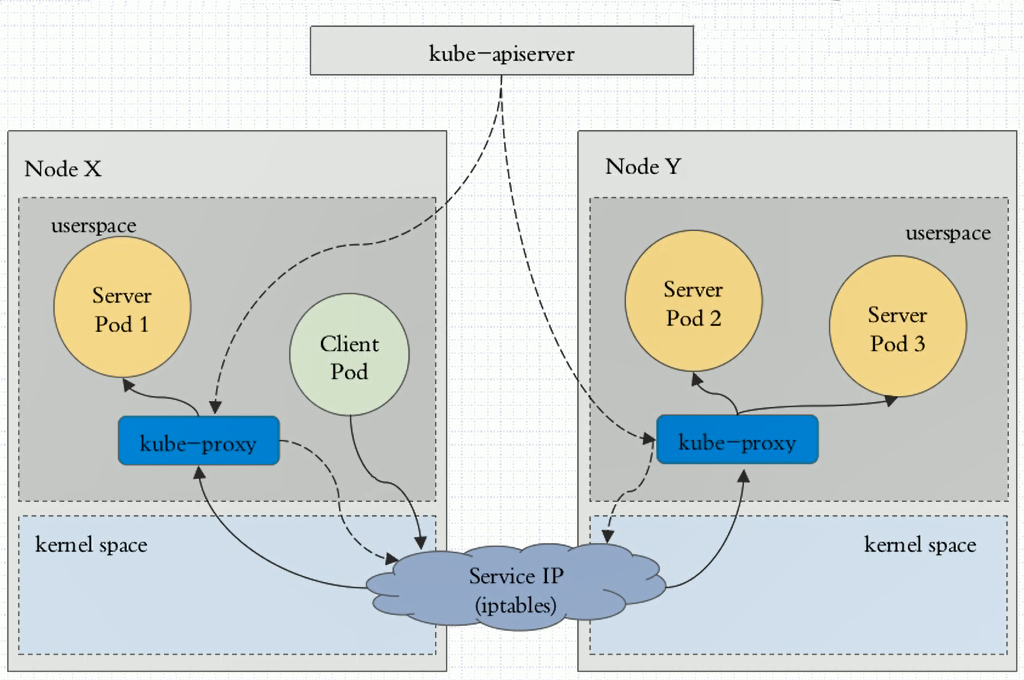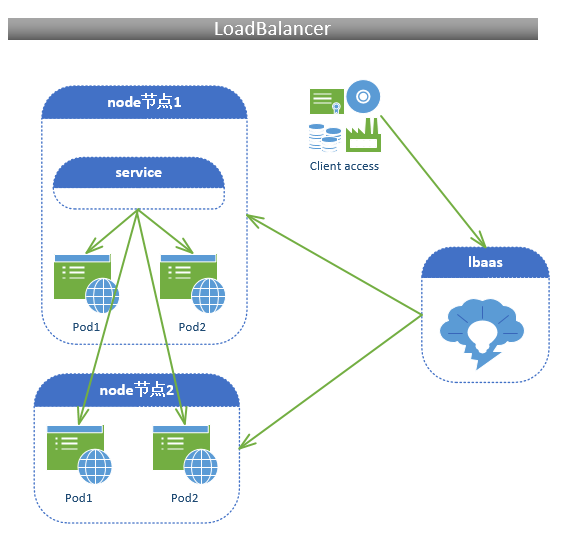docker+k8s基础篇五
Docker+K8s基础篇(五)
- service资源介绍
- A:service资源的工作特性
- service的使用
- A:service字段介绍
- B:ClusterIP的简单使用
- C:NodePort的简单使用
- D:LoadBalancer和ExternalName
- E:无头service
♣一:service资源介绍
A:service资源的工作特性:
kubernetes的service资源:
在整个k8s集群的节点中pods资源是最小的对象,这些对象是提供真正服务的重要组成部分,当我们需要通过外部进行访问的时候因各pod资源提供的访问端点是不一致的,我们就需要设定一个固定的访问端点来提供访问,这个访问端点,是存在pod至上和控制器之下的中间层,这个中间层将叫service,service会严格依赖k8s上的一个重要组件叫coredns(新版本)和kube-dns(老版本1.11之前的版本),所以我们在部署的时候必需要部署coredes或者kube-dns。
kubernetes要想给客户端提供网络功能,需要依赖于第三方方案,这种方案在新版本中可以通过cni(容器网络插件标准接口)来接入任何遵循这种标准的第三方方案,例如我们使用到的flannel。
kubernetes的三类ip地址:
1:node网络
2:pod网络
node和pod的地址是实际存在且配置了。
3:cluater(集群地址)或者叫做service地址,这种地址是虚拟的地址(virtual ip),这些地址没有出现在接口之上,仅仅只是出现在service的规则当中。
在每个节点之上都工作了kube-proxy组件,这个组件将会实时监视service资源中的变动信息,这个监视是由kube-proxy通过一种固有的方式(watch)请求方式来实现的,一旦service的资源发生变动,kube-proxy都要将其转换为当前节点之上的能够被service调度的规则之上(这个规则可能是iptables或者ipvs规则,取决于service的实现方式)
service的实现方式在k8s上有三种模型:

1:userspace(用户空间)
当用户的访问请求会先到达service上,由service将其转换监听在某个套接字上的用户空间内的kube-proxy,接下来kube-proxy处理完成之后再转给service代理至这个service各个相 关联的pod之上,实现调度。
这种模型效率不高,因为用户请求要进过工作在内核上的service转给工作各个“主机”之上用户空间的kube-proxy,kube-proxy将其封装成请求报文发送给内核空间的service资源, 有service的规则在调度至各个pod资源上。

2:iptabeles:
当前用户请求直接请求service的IP,这个请求会被工作在本地内核空间中的service所截取,然后直接调度给相关联的pod,而整个调度都是基于iptables规则来完成的。

3:ipvs:
和iptables一样,只不过规则换成了ipvs规则。
在配置k8s的时候设定k8s工作在什么模式之下,就会生成对应模式的规则,1.1之前默认是userspace,1.11默认使用的ipvs,如果ipvs没有激活,就会降级为iptables。
当集群中的pods资源发生了改变,这个信息会立马反应到apiservice之上,因为这个改变会直接存储在apiservice的ectd当中,这种变化也会立即触发kube-proxy并发送给service资源中将其转换为iptables或者ipvs规则,这些转换都是动态且实时的。
♣二:service的使用:
A:service字段介绍:
- [root@www kubeadm]# kubectl get svc
- NAME TYPE CLUSTER-IP EXTERNAL-IP PORT(S) AGE
- kubernetes ClusterIP 10.96.0.1 <none> 443/TCP 77m
- 在我们初始化集群的时候已然帮忙创建了一个名称叫kubernetes的service资源,这个资源很重要,是保证我们service和集群节点之间联系的,而且10.96.0.1是面向集群内部的地址。
- [root@www kubeadm]# kubectl explain svc 也是包含5个一级字段
- KIND: Service
- VERSION: v1
- DESCRIPTION:
- Service is a named abstraction of software service (for example, mysql)
- consisting of local port (for example 3306) that the proxy listens on, and
- the selector that determines which pods will answer requests sent through
- the proxy.
- FIELDS:
- apiVersion <string>
- APIVersion defines the versioned schema of this representation of an
- object. Servers should convert recognized schemas to the latest internal
- value, and may reject unrecognized values. More info:
- https://git.k8s.io/community/contributors/devel/api-conventions.md#resources
- kind <string>
- Kind is a string value representing the REST resource this object
- represents. Servers may infer this from the endpoint the client submits
- requests to. Cannot be updated. In CamelCase. More info:
- https://git.k8s.io/community/contributors/devel/api-conventions.md#types-kinds
- metadata <Object>
- Standard object's metadata. More info:
- https://git.k8s.io/community/contributors/devel/api-conventions.md#metadata
- spec <Object>
- Spec defines the behavior of a service.
- https://git.k8s.io/community/contributors/devel/api-conventions.md#spec-and-status
- status <Object>
- Most recently observed status of the service. Populated by the system.
- Read-only. More info:
- https://git.k8s.io/community/contributors/devel/api-conventions.md#spec-and-status
- [root@www kubeadm]# kubectl explain svc.spec.ports(ports是用于把那个端口和后端的容器端口建立关联关系)
- KIND: Service
- VERSION: v1
- RESOURCE: ports <[]Object>
- DESCRIPTION:
- The list of ports that are exposed by this service. More info:
- https://kubernetes.io/docs/concepts/services-networking/service/#virtual-ips-and-service-proxies
- ServicePort contains information on service's port.
- FIELDS:
- name <string>
- The name of this port within the service. This must be a DNS_LABEL. All
- ports within a ServiceSpec must have unique names. This maps to the 'Name'
- field in EndpointPort objects. Optional if only one ServicePort is defined
- on this service.
- nodePort <integer>
- The port on each node on which this service is exposed when type=NodePort
- or LoadBalancer. Usually assigned by the system. If specified, it will be
- allocated to the service if unused or else creation of the service will
- fail. Default is to auto-allocate a port if the ServiceType of this Service
- requires one. More info:
- https://kubernetes.io/docs/concepts/services-networking/service/#type-nodeport
- port <integer> -required- service的端口
- The port that will be exposed by this service.
- protocol <string> node端口
- The IP protocol for this port. Supports "TCP", "UDP", and "SCTP". Default
- is TCP.
- targetPort <string> pods端口
- Number or name of the port to access on the pods targeted by the service.
- Number must be in the range 1 to 65535. Name must be an IANA_SVC_NAME. If
- this is a string, it will be looked up as a named port in the target Pod's
- container ports. If this is not specified, the value of the 'port' field is
- used (an identity map). This field is ignored for services with
- clusterIP=None, and should be omitted or set equal to the 'port' field.
- More info:
- https://kubernetes.io/docs/concepts/services-networking/service/#defining-a-service
- [root@www kubeadm]# kubectl explain svc.spec.selector (我们需要关联到哪些pods资源上)
- KIND: Service
- VERSION: v1
- FIELD: selector <map[string]string>
- DESCRIPTION:
- Route service traffic to pods with label keys and values matching this
- selector. If empty or not present, the service is assumed to have an
- external process managing its endpoints, which Kubernetes will not modify.
- Only applies to types ClusterIP, NodePort, and LoadBalancer. Ignored if
- type is ExternalName. More info:
- https://kubernetes.io/docs/concepts/services-networking/service/
- spec.clusterIP(指定固定的ip,创建之后无法改变)
- [root@www kubeadm]# kubectl explain svc.spec.type (service的类型)
- KIND: Service
- VERSION: v1
- FIELD: type <string>
- DESCRIPTION:
- type determines how the Service is exposed. Defaults to ClusterIP. Valid
- options are ExternalName, ClusterIP, NodePort, and LoadBalancer.
- "ExternalName" maps to the specified externalName. "ClusterIP" allocates a
- cluster-internal IP address for load-balancing to endpoints. Endpoints are
- determined by the selector or if that is not specified, by manual
- construction of an Endpoints object. If clusterIP is "None", no virtual IP
- is allocated and the endpoints are published as a set of endpoints rather
- than a stable IP. "NodePort" builds on ClusterIP and allocates a port on
- every node which routes to the clusterIP. "LoadBalancer" builds on NodePort
- and creates an external load-balancer (if supported in the current cloud)
- which routes to the clusterIP. More info:
- https://kubernetes.io/docs/concepts/services-networking/service/#publishing-services-service-types
service资源的字段介绍
svc.spec.type字段类型:
类型一共分为4种:
1:ExternalName(把集群外部的服务引入到集群内部直接使用);
2:ClusterIP;
3:NodePort(接入外部);
4:LoadBalancer(支持lbaas负载均衡的一键调度)
B:ClusterIP的简单使用:
- [root@www TestYaml]# cat redis-svc.yaml
- apiVersion: v1
- kind: Service
- metadata:
- name: redis
- namespace: default
- spec:
- selector:
- app: redis
- clusterIP: 10.98.98.98 (指定ip创建的时候需要注意网段和地址冲突问题)
- type: ClusterIP
- ports:
- - port: 6379
- targetPort: 6379
- [root@www TestYaml]# kubectl apply -f redis-svc.yaml
- service/redis created
- [root@www TestYaml]# kubectl get svc
- NAME TYPE CLUSTER-IP EXTERNAL-IP PORT(S) AGE
- kubernetes ClusterIP 10.96.0.1 <none> 443/TCP 102m
- redis ClusterIP 10.98.98.98 <none> 6379/TCP 14s 可以看到redis的ip和端口是配置文件指定的ip和端口
- [root@www TestYaml]# kubectl describe svc redis
- Name: redis
- Namespace: default
- Labels: <none>
- Annotations: kubectl.kubernetes.io/last-applied-configuration:
- {"apiVersion":"v1","kind":"Service","metadata":{"annotations":{},"name":"redis","namespace":"default"},"spec":{"clusterIP":"10.98.98.98","...
- Selector: app=redis
- Type: ClusterIP
- IP: 10.98.98.98
- Port: <unset> 6379/TCP 指定的service端口
- TargetPort: 6379/TCP 指定的pod端口
- Endpoints: <none>
- Session Affinity: None
- Events: <none>
- 这里需要说明的是service不会直接到pod,而是需要进过中间层Endpoints的,Endpoints也是k8s上标准的对象,再由Endpoints关联至pods资源上。
ClusterIP案例
C:NodePort的简单使用:
- [root@www TestYaml]# cat NodePort.svc.yaml
- apiVersion: v1
- kind: Service
- metadata:
- name: myapp
- namespace: default
- spec:
- selector:
- app: myapp
- clusterIP: 10.99.99.99
- type: NodePort
- ports:
- - port: 8088
- targetPort: 8088
- nodePort: 30008 从30000到32767之间的都可以,默认是动态分配的
- [root@www TestYaml]# kubectl apply -f NodePort.svc.yaml
- service/myapp created
- [root@www TestYaml]# kubectl get svc
- NAME TYPE CLUSTER-IP EXTERNAL-IP PORT(S) AGE
- kubernetes ClusterIP 10.96.0.1 <none> 443/TCP 125m
- myapp NodePort 10.99.99.99 <none> 8088:30008/TCP 22s service的8088端口映射成node上的30008
- redis ClusterIP 10.98.98.98 <none> 6379/TCP 23m
- 通过此种方式创建的pod就可以在外部直接访问了,只不过要进过好几级转换,先是port,再是protocol,在转换到targetPort上。
NodePort案例
D:LoadBalancer和ExternalName:

如果购买了阿里云平台的环境虚拟机(带ibaas负载均衡服务),你在上面搭建了一共k8s的集群服务,k8s会自动去调用云平台的ibaas服务,用软件的方式去把用户的访问请求负载调度至后端的任意一个node节点上,在由节点上的service服务再负载调度至后端的任意一个pod之上,整个过程都是自动的,而且是两级负载均衡调度。
ExternalName:
我们在构建pods的时候本来就是层级关系的,例如db被tomcat访问,tomcat被nginx访问,这种被访问的形式本身就是一种client的存在,那如果是我们的nginx服务在集群外部的某台集群上,想nginx能访问到集群内部的tomcat就需要使用ExternalName,在创建yaml文件的时候ExternalName是一个真实有效且能被dns所解析的服务名,然后用户的访问请求走外部的nginx,nginx在发送请求报文给集群内部的nodeIP到service,有service调度到后端的pod(tomcat),pod在返回给service,最后返回到nginx上,实现访问,但是此种方式用的不多。
- [root@www kubeadm]# kubectl explain svc.spec.externalName (externalName只能是类型为ExternalName的时候才有效)
- KIND: Service
- VERSION: v1
- FIELD: externalName <string>
- DESCRIPTION:
- externalName is the external reference that kubedns or equivalent will
- return as a CNAME record for this service. No proxying will be involved.
- Must be a valid RFC-1123 hostname (https://tools.ietf.org/html/rfc1123) and
- requires Type to be ExternalName.
- [root@www kubeadm]#
externalName字段说明
- [root@www kubeadm]# kubectl explain svc.spec.sessionAffinity(svc还支持sessionAffinity)
- KIND: Service
- VERSION: v1
- FIELD: sessionAffinity <string>
- DESCRIPTION:
- Supports "ClientIP" and "None". Used to maintain session affinity. Enable
- client IP based session affinity. Must be ClientIP or None. Defaults to
- None. More info:
- https://kubernetes.io/docs/concepts/services-networking/service/#virtual-ips-and-service-proxies
- 这里的session支持两种,一个是ClientIP,将来自同一个ip访问的请求始终调度到同一个pod上。
- None就是默认的随机调度。
sessionAffinity字段说明
E:无头service:
无头service,即值创建service的时候不指定clusterIP,此时用户的访问请求不再是访问clusterIP而是转而访问pod上的ip
- [root@www TestYaml]# kubectl explain svc.spec.clusterIP
- KIND: Service
- VERSION: v1
- FIELD: clusterIP <string>
- DESCRIPTION:
- clusterIP is the IP address of the service and is usually assigned randomly
- by the master. If an address is specified manually and is not in use by
- others, it will be allocated to the service; otherwise, creation of the
- service will fail. This field can not be changed through updates. Valid
- values are "None", empty string (""), or a valid IP address. "None" can be
- specified for headless services when proxying is not required. Only applies
- to types ClusterIP, NodePort, and LoadBalancer. Ignored if type is
- ExternalName. More info:
- https://kubernetes.io/docs/concepts/services-networking/service/#virtual-ips-and-service-proxies
- 在指定clusterIP的时候可以指定为none(格式是""即可)
- 案例:
- [root@www TestYaml]# cat NodePort.svc.yaml
- apiVersion: v1
- kind: Service
- metadata:
- name: myapp
- namespace: default
- spec:
- selector:
- app: myapp
- clusterIP: None 不指定ip
- ports:
- - port: 8088
- targetPort: 8088
- [root@www TestYaml]# kubectl get svc
- NAME TYPE CLUSTER-IP EXTERNAL-IP PORT(S) AGE
- kubernetes ClusterIP 10.96.0.1 <none> 443/TCP 81m
- myapp ClusterIP None <none> 8088/TCP 9s 可以看到ip是none标记
- [root@www TestYaml]# kubectl get svc -n kube-system
- NAME TYPE CLUSTER-IP EXTERNAL-IP PORT(S) AGE
- kube-dns ClusterIP 10.96.0.10 <none> 53/UDP,53/TCP,9153/TCP 83m 我们直接去解析coredns的ip就能直接看到pod ip的解析记录
- [root@www TestYaml]# dig -t A myapp.default.svc.cluster.local. @10.96.0.10 我们直接解析coredns的ip看看下解析记录
- ; <<>> DiG 9.9.4-RedHat-9.9.4-74.el7_6.1 <<>> -t A myapp.default.svc.cluster.local. @10.96.0.10
- ;; global options: +cmd
- ;; Got answer:
- ;; ->>HEADER<<- opcode: QUERY, status: NOERROR, id: 60422
- ;; flags: qr aa rd; QUERY: 1, ANSWER: 3, AUTHORITY: 0, ADDITIONAL: 1
- ;; WARNING: recursion requested but not available
- ;; OPT PSEUDOSECTION:
- ; EDNS: version: 0, flags:; udp: 4096
- ;; QUESTION SECTION:
- ;myapp.default.svc.cluster.local. IN A
- ;; ANSWER SECTION:
- myapp.default.svc.cluster.local. 5 IN A 10.244.2.9 可以看到这里有三个记录,ip分别是2.9,2.8,1.8
- myapp.default.svc.cluster.local. 5 IN A 10.244.2.8
- myapp.default.svc.cluster.local. 5 IN A 10.244.1.8
- ;; Query time: 0 msec
- ;; SERVER: 10.96.0.10#53(10.96.0.10)
- ;; WHEN: 日 7月 14 11:29:23 CST 2019
- ;; MSG SIZE rcvd: 201
- [root@www TestYaml]# kubectl get pods -o wide
- NAME READY STATUS RESTARTS AGE IP NODE NOMINATED NODE READINESS GATES
- myapp-9758dcb6b-hl957 1/1 Running 0 4m6s 10.244.2.8 www.kubernetes.node1.com <none> <none>
- myapp-9758dcb6b-z8rk6 1/1 Running 0 4m6s 10.244.2.9 www.kubernetes.node1.com <none> <none>
- myapp-9758dcb6b-zl5jt 1/1 Running 0 4m6s 10.244.1.8 www.kubernetes.node2.com <none> <none>
- 上面的2.9,2.8,1.8对应的ip就是pod的ip,这样我们得出的结论就是当service没有clusterip的时候就会通过coredns来解析并转发到后端的pod之上。
无头service案例
service很好用,但是也是存在缺陷的,当面我们创建了service的时候,用户访问需要进行两级转换,如果是阿里云的lbaas则是两级调度,其实我们看到的是两级转换,但是落到ipvs或者iptebles之上就是四层调度。因为ipvs和iptables都是四层的,如果我们建立的是https服务的话,例如https对应的名称是myapp,那么你的每一个myapp都要配置成htpps的主机,因为ipvs或者iptables自身是无法卸载https会话的。
kubernetes还有一种引入外部流量的方式,叫ingress(是一种7层调度器)将外部的流量引入到内部来,但是也是无法脱离service的工作,必需要用pod7层功能的应用来调度,起能提供的应用有nginx,haprxoy等。在kubernetes之上应用比较多的是nginx,当然还有别的应用有各自相应的优势。
docker+k8s基础篇五的更多相关文章
- docker+k8s基础篇一
Docker+K8s基础篇(一) docker的介绍 A:为什么是docker B:k8s介绍 docker的使用 A:docker的安装 B:docker的常用命令 C:docker容器的启动和操作 ...
- docker+k8s基础篇四
Docker+K8s基础篇(四) pod控制器 A:pod控制器类型 ReplicaSet控制器 A:ReplicaSet控制器介绍 B:ReplicaSet控制器的使用 Deployment控制器 ...
- docker+k8s基础篇三
Docker+K8s基础篇(三) kubernetes上的资源 A:k8s上的常用资源 Pod的配置清单 A:Pod上的清单定义 B:Pod创建资源的方法 C:spec下其它字段的介绍 Pod的生命周 ...
- docker+k8s基础篇二
Docker+K8s基础篇(二) docker的资源控制 A:docker的资源限制 Kubernetes的基础篇 A:DevOps的介绍 B:Kubernetes的架构概述 C:Kubernetes ...
- 小白学Docker之基础篇
系列文章: 小白学Docker之基础篇 小白学Docker之Compose 小白学Docker之Swarm PS: 以下是个人作为新手小白学习docker的笔记总结 1. docker是什么 百科上的 ...
- Docker之基础篇
小白学Docker之基础篇 系列文章: 小白学Docker之基础篇 小白学Docker之Compose 小白学Docker之Swarm PS: 以下是个人作为新手小白学习docker的笔记总结 1 ...
- C#基础篇五值类型和引用类型
using System; using System.Collections.Generic; using System.Linq; using System.Text; namespace P01M ...
- Hybrid APP基础篇(五)->JSBridge实现示例
说明 JSBridge实现示例 目录 前言 参考来源 楔子 JS实现部分 说明 实现 Android实现部分 说明 JSBridge类 实现 Callback类 实现 Webview容器关键代码 实现 ...
- Python基础篇(五)
bool用于判断布尔值的结果是True还是False >>> bool("a") True >>> bool(3) True >>& ...
随机推荐
- 异常检测(Anomaly detection): 异常检测算法(应用高斯分布)
估计P(x)的分布--密度估计 我们有m个样本,每个样本有n个特征值,每个特征都分别服从不同的高斯分布,上图中的公式是在假设每个特征都独立的情况下,实际无论每个特征是否独立,这个公式的效果都不错.连乘 ...
- wiki with 35(dp+矩阵快速幂)
Problem J. Wiki with 35Input file: standard input Time limit: 1 secondOutput file: standard output M ...
- SpringBoot学习(五)RSocket和Security
一.RSocket RSocket是一个用于字节流传输的二进制协议.它通过在单个连接上传递异步消息来支持对称交互模型,主要支持的通讯层包括 TCP, WebSockets和Aeron(UDP). RS ...
- 文件搜索命令find
1.路径加文件名搜索(find): 查找的是etc目录下的以init为名字的文件. 加通配符后为模糊搜索,只要文件名中含有init即可. 查找etc目录下以init开头的七位文件名. 2.搜索时不区分 ...
- Bzoj 1927: [Sdoi2010]星际竞速(网络流)
1927: [Sdoi2010]星际竞速 Time Limit: 20 Sec Memory Limit: 259 MB Description 10年一度的银河系赛车大赛又要开始了.作为全银河最盛大 ...
- 【loj2552】【CTSC2018】假面
题目 有\(n\)个敌方单位,初始生命值分别为\(m_1,\cdots,m_n\) : 假面可以释放\(Q\)个技能: $op = 0 , id , u , v $ 表示对\(id\)号敌人有\( ...
- 在windows环境下可以裁剪.jpg格式的图片
发现在windows操作系统下,可以利用图片编辑器裁剪.jpg格式的尺寸大小.其四方有四个推子.可以移动.注意点击右方的“确定”按钮.
- Redis BGSAVE因为内存不足 fork 失败导致目标 Redis 无法访问的问题
中秋的时候正在外面愉快的在外卖喝着咖啡玩电脑......突发 redis 报警从 sentry 应用端曝出的错误 MISCONF Redis is configured to save RDB sna ...
- javascript加密之md5加密
原作地址:JavaScriptMd5 修改备用:JavaScriptMd5.rar
- office2010安装不了提示已经安装32位的了怎么办
1.打开控制面板,查看是否有安装的程序没有拆卸,如果没有继续往下看,如果有直接拆卸掉,再进行下面的步骤. 2.首先打开注册列表.按下win+R键即可打开,输入regedit,也可以在开始菜单中搜索re ...
